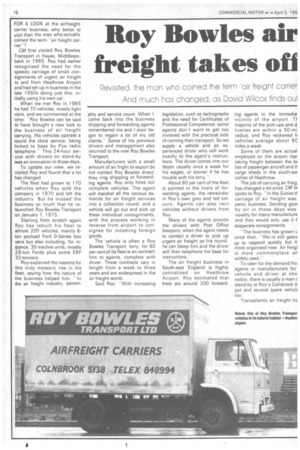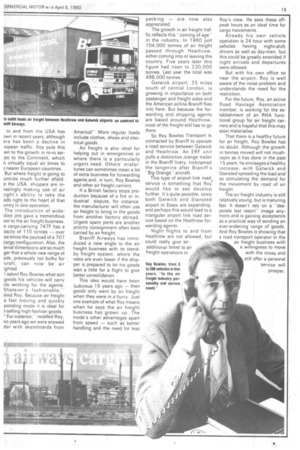Roy Bowles air freight takes oil
Page 20

Page 21

If you've noticed an error in this article please click here to report it so we can fix it.
FOR A LOOK at the airfreight carrier business, who better to visit than the man who actually coined the term "air freight carrier"?
CM first visited Roy Bowles Transport in Hayes, Middlesex, back in 1965. Roy had earlier recognised the need for the speedy carriage of small consignments of urgent air freight to and from Heathrow Airport and had set up in business in the late 1950s doing just this, initially using his own car.
When we met Roy in 1965 he had 70 vehicles, mostly light vans, and we commented at the time: -Roy Bowles can be said to have brought a new look to the business of air freight carrying. His vehicles operate a round the clock service, being linked to base by Pye radio telephone.This 24-hour service with drivers on stand-by was an innovation in those days.
To update our view, we revisited Roy and found that a lot has changed.
The fleet had grown to 170 vehicles when Roy sold the company in 1 970 and left the industry. But he missed the business so much that he relaunched Roy Bowles Transport on January 1, 1975.
Starting from scratch again Roy has rebuilt his fleet to almost 200 vehicles, mainly 6ton payload Ford D-Series box vans but also including, for instance, 35 tractive units, mostly 28-ton Fords plus some ERF 32-tonners.
Roy explained the reasons for this truly meteoric rise in his fleet, saying how the nature of the business helped him. "In the air freight industry, person ality and service count. When I came back into the business shipping and forwarding agents remembered me and I soon began to regain a lot of my old clients." Some of his previous drivers and management also returned to the new Roy Bowles Transport.
Manufacturers with a small amount of air fright to export do not contact Roy Bowles direct, they ring shipping or forwarding agents. Roy only hires out complete vehicles. The agent will marshal all the various demands for air freight services into a collection round, and a vehicle will go out and pick up these individual consignments, with the process working in reverse from airport to consignee for incoming foreign goods.
The vehicle is often a Roy Bowles Transport lorry, for 80 per cent of its fleet is on contract hire to agents, complete with driver. These contracts vary in length from a week to three years and are widespread in the air freight world.
Said Roy. -With increasing legislation, such as tachographs and the need for Certificates of Professional Competence, some agents don't want to get too involved with the practical side of running their transport. So we supply a vehicle and an experienced driver who will work exactly to the agent's instructions. The driver comes into our depot usually once a week for his wages, or sooner if he has trouble with his lorry.
About 60 per cent of the fleet is painted in the livery of forwarding agents, the remainder in Roy's own grey and red colours. Agents can also rent vehicles without drivers from Roy.
Many of the agents provide the drivers with Post Office bleepers; when the agent needs to contact a driver to pick up urgent air freight on his round, he can bleep him and the driver will then telephone his base for instructions.
The air freight business in South-east England is highly centralised on Heathrow Airport. Roy estimated that there are around 200 forward
ing agents in the immedia. vicinity of the airport. TImajority of the pick-ups and d liveries are within a 50-mi radius, and Roy reckoned h vehicles average about 60 miles a week.
Some of them are actual employed on the airport itse taking freight between the b( lies of passenger aircraft and 0cargo sheds in the south-we corner of Heathrow.
The job of carrying air freig has changed a lot since CM la spoke to Roy. "In the Sixties tf carriage of air freight was panic business. Sending goo( by air in those days was novelty for many manufacture and they would only use it f desperate consignments.
-The business has grown u since then. -We're still geare up to respond quickly but it more organised now. Air freigl is more commonplace an widely used.'
To cater for the demand froi agents or manufacturers for vehicle and driver at sho notice, there is usually a man c stand-by at Roy's Colnbrook d pot and several spare vehicli too.
Transatlantic air freight tre to and from the USA has Dwn in recent years, although ere has been a decline in ropean traffic. Roy puts this wn to the growth in ro-ro ser:es to the Continent, which n virtually equal air times to nearer European countries. But where freight is going to untries much further afield, e the USA, shippers are inmsingly making use of air iight's ability to take the ods right to the heart of that untry in one operation.
The introduction of widedied jets gave a tremendous ost to the air freight business.
e cargo-carrying 747F has a Dacity of 110 tonnes — over eetirries the payload of a 707 cargo configuration. Also, the ernal dimensions are so much ger that a whole new range of ods, previously too bulky for .craft, can now be air ighted.
I asked Roy Bowles what sort goods his vehicles will carry ilie working for the agents. Vhatever's fashionable,)lied Roy. Because air freight a fast moving and quickly ,ponding mode it is ideal for t-selling high-fashion goods. -For instance," recalled Roy, vo years ago we were snowed der with skateboards from
America!" More regular loads include clothes, shoes and electrical goods.
Air freight is also ideal for helping out in emergencies or where there is a particularly urgent need. Others misfortunes can sometimes mean a lot of extra business for forwarding agents and, in turn, Roy Bowles and other air freight carriers.
If a British factory stops production because of a fire or industrial dispute, for instance, the manufacturer will often use air freight to bring in the goods from another factory abroad. Urgent spare parts are another priority consignment often best carried by air freight.
Braniff Airways has introduced a new angle to the air freight business with its standby freight system, where the rates are even lower if the shipper is prepared to let his goods wait a little for a flight to give better consolidation.
This idea would have been ludicrous 15 years ago — then goods only went by air freight when they were in a hurry. Just one example of what Roy means when he says the air freight business has grown up. The mode's other advantages apart from speed — such as better handling and the need for less packing — are now also appreciated.
The growth in air freight traffic reflects this "coming of age" in the industry. In 1960 just 104,000 tonnes of air freight passed through Heathrow, either coming into or leaving the country. Five years later this figure had risen to 230,000 tonnes. Last year the total was 498,000 tonnes.
Gatwick airport, 25 miles south of central London, is growing in importance on both passenger and freight sides and the American airline Braniff flies into here. But because the forwarding and shipping agents are based around Heathrow, most of the freight still has to go there.
So Roy Bowles Transport is contracted by Braniff to operate a road service between Gatwick and Heathrow. An ERF unit pulls a distinctive orange trailer in the Braniff livery, nicknamed the tangerine after Braniff's "Big Orange" aircraft.
This type of airport link road. service is something that Roy
would like to see develop further. It's quite possible, since both Gatwick and Stansted airport in Essex are expanding, and perhaps this would lead to a triangular airport link road service based on the Heathrow forwarding agents.
Night flights to and from Heathrow are not allowed, but could really give an additional boost to air freight operations in Roy's view. He sees these offpeak hours as an ideal time for cargo movements.
Already his own vehicle operation is 24 hour with some .,vehicles having night-shift drivers as well as day-men, but this could be greatly extended if night arrivals and departures were allowed.
But with his own office so near the airport, Roy is well aware of the noise problem and understands the need for the restriction.
For the future, Roy, an active Road Haulage Association member, is working for the establishment of an RHA functional group for air freight carriers and is hopeful that this may soon materialise.
That there is a healthy future for air freight, Roy Bowles has no doubt. Although the growth in tonnes moved will not mushroom as it has done in the past 15 years, he envisages a healthy increase, with Gatwick and Stansted spreading the load and so stimulating the demand for the movement by road of air freight.
The air freight industry is still relatively young, but is maturing fast. It doesn't rely on a "desperate last resort" image anymore and is gaining acceptance as a practical way of sending an ever-widening range of goods. And Roy Bowles is showing that a road transport operator in the air freight business with a willingness to move with the times and still offer a personal service will prosper.




































































































